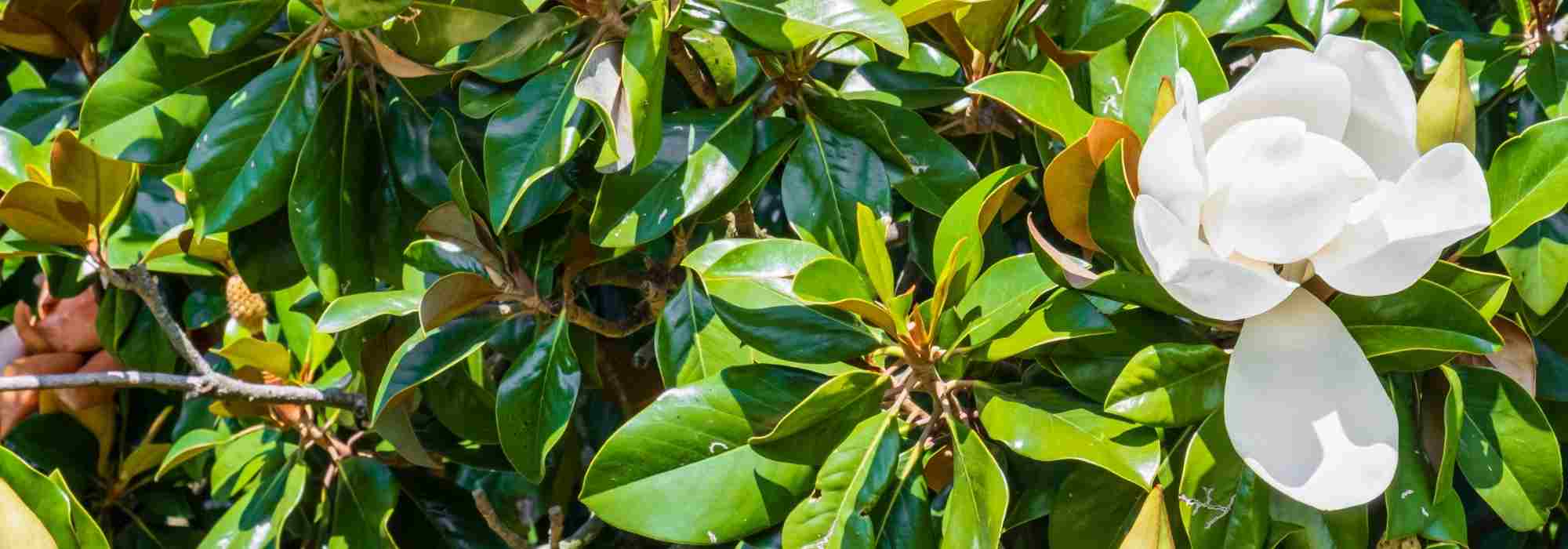
7 trees for an urban garden
Selection of trees suitable for your city garden
Contents
Garden without a tree? Impossible! Even on small urban garden plots, you can afford the luxury of planting a tree that will be the focal point of the garden… provided you choose one with adult dimensions suited to your peaceful haven. Because we want to avoid at all costs the all-too-common situation where a tree has grown so large that it casts too much shade over living areas and the garden, and must be felled. The important thing is therefore to favour a tree of moderate growth, with a narrow habit (fastigiate), or rounded, even spreading, which may help screen an intrusive neighbouring view, a building or an overbearing pillar. Some weeping forms are also worth considering. The second imperative is their resistance to polluted urban atmospheres. Finally, the shade it will provide in summer is another important criterion before deciding.
Choosing a tree is not to be taken lightly, so here is a varied selection to help you find a tree with a spreading of no more than 4 m that can fit into a small urban garden.
Betula pendula 'Fastigiata': majesty in winter
Birches are ideal trees for the challenging conditions of an urban garden, coping perfectly with polluted air and degraded soils. In a small town garden, view from living space becomes important: a tree such as the birch, deciduous in winter, revealing its sublime sculptural pale bark, is an attractive option as it will not cast shade during the year’s shortest days.
The Betula pendula ‘Fastigiata’, with an almost columnar habit, can be planted in a long, medium-sized town garden: Reaching about 10 m high by 4 m wide at maturity, it is fast-growing, undemanding about soil, and prefers a sunny to partially shaded position. Its very light shade is a blessing in midsummer. Its branches are upright and twisted, foliage light green turning golden. You can use it in many garden styles, contemporary, classic or romantic.
For a slightly smaller, squarer garden, the cultivar ‘Youngii’, measuring 5 m in every direction, notable for its habit both trailing and umbrella-shaped, will provide light shade over a wide diameter, much appreciated in high summer.
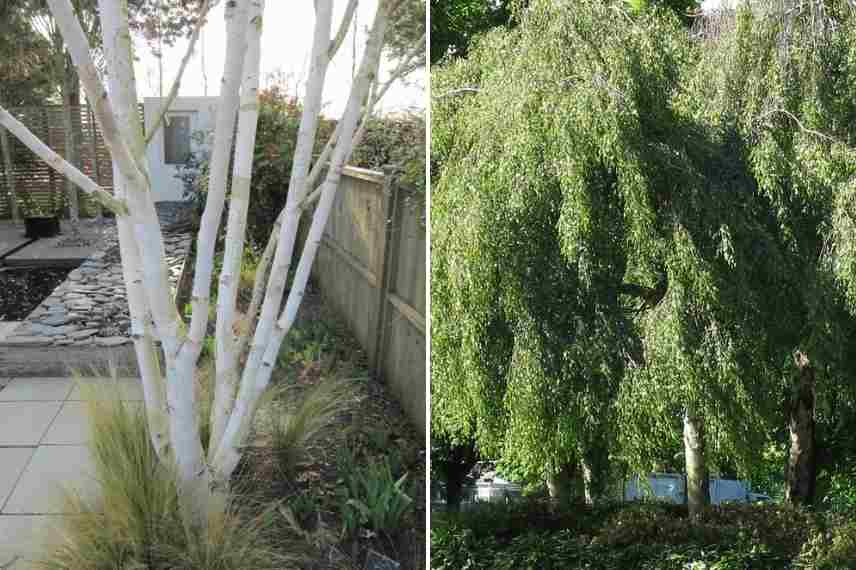
Betula fastigiata (Photo: L. Enking) on the left; Betula ‘Youngii’ (Photo: W. Cutler) on the right
→ Discover our complete fact sheet on Birches and Olivier’s video on birch ‘Youngii’
Read also
7 trees for small gardensStewartia: flowering, foliage, bark — it has it all
From same family as camellias, but deciduous, les Stewartias are beautiful small trees of limited development at ripeness, not exceeding 6 m by 2.50 m or 4 m, with upright, even columnar habit depending on species. The upward-pointing branching is perfect for small urban gardens, tree then gradually spreading. Hardy, requiring fresh soil and a partial-shade position, an aspect often found in town gardens, it combines qualities: long flowering throughout summer, delicate crumpled white cup-shaped flowers striking against orange-yellow stamens, corrugated leaves, superb autumn foliage, sublime bark peeling with age… Sheltered from winds, it will be perfect in a protected town garden. It can really suit any garden style!
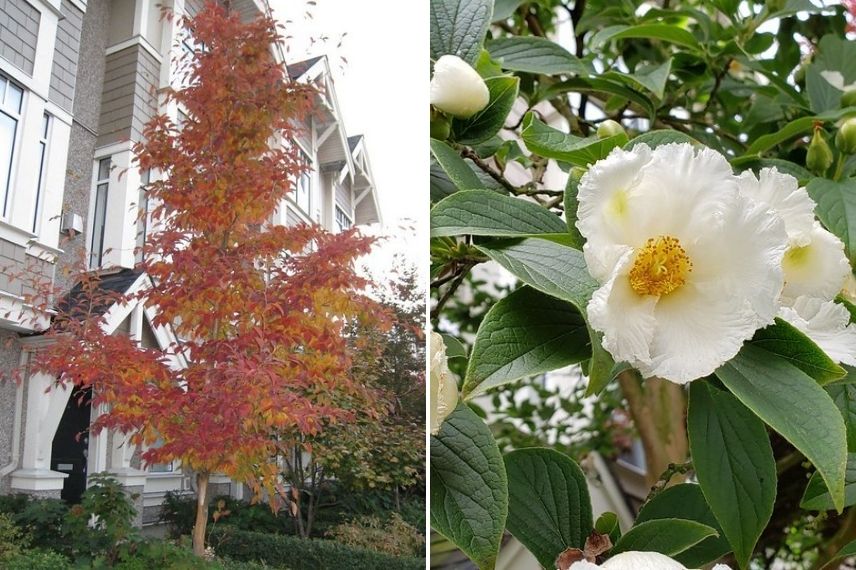
Stewartia pseudocamellia (Photo: W. Culter)
→ Discover our full fact sheet on the Stewartia pseudocamellia
Discover other Urban garden
View all →Available in 0 sizes
Available in 0 sizes
Available in 1 sizes
Available in 1 sizes
Available in 2 sizes
Available in 0 sizes
Available in 2 sizes
Available in 2 sizes
Available in 1 sizes
Available in 1 sizes
Ginkgo biloba 'Blagon': a unique focal point
The Ginkgo or tree of forty coins, well known for surviving the atomic bombing, is a legendary deciduous tree, living fossil, millennial tree. It therefore easily resists urban pollution, and dimensions of some cultivars now allow it to be planted in small sunny gardens. It therefore naturally features in this selection with ‘Blagon’: the unique two-lobed foliage, like small fans, and the golden autumnal colours are of course stunning. Its columnar habit, about 10 m x 2 m, is ideal for a medium-sized urban garden, rectangular in shape. Please note that Ginkgo biloba ‘Blagon’ will reach these dimensions after several years, as it grows slowly. It will create a striking focal point in your urban garden! (please note: ‘Princeton Sentry’ is another cultivar with a similarly upright habit).
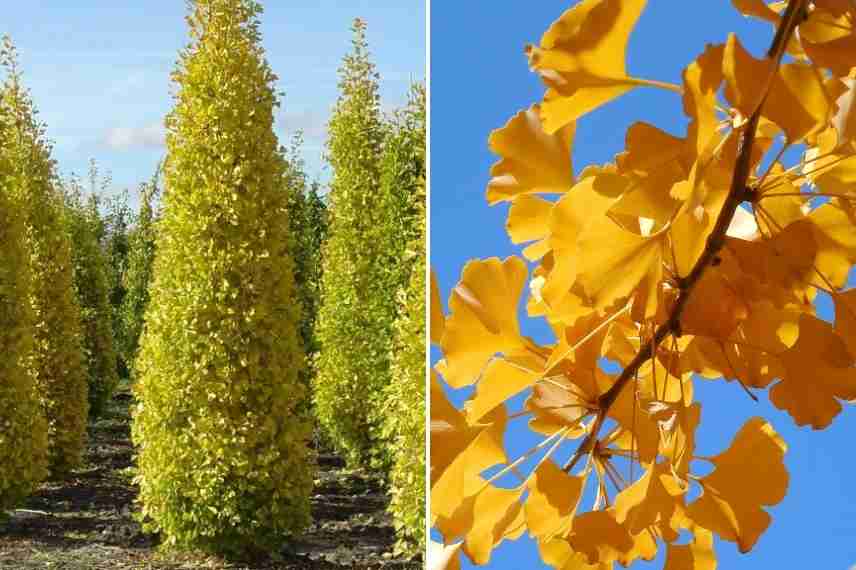
Ginkgo biloba ‘Blagon’ on left, remarkable foliage in its autumnal hues on right
→ Discover our full fact sheet on the Gingko biloba
Read also
Designing a city gardenMagnolia grandiflora 'Alta': elegance in the garden
Magnolias are wonderful trees (or often bushes when their foliage is deciduous) suited to small urban gardens because of their narrow, conical habit, and their tolerance of urban pollution. One of the great attractions of Magnolia grandiflora ‘Alta’, besides its magnificent glossy evergreen foliage, lies in its magnificent white flowers that bloom throughout summer from a young age, which is rare in Magnolias. Dimensions of this small highly ornamental tree (6 m x 1.5 m) make it suitable for an urban garden of at least 150 m², where it will be showcased either as a coppice (with multiple trunks) or trained as a standard. Ultra hardy, it nevertheless needs sun to flower well. It can be planted as a specimen, or within a bed of acid soil. You can prune it in late winter to emphasise its pyramidal shape and keep it within desired dimensions, or prune lower branches to allow passage underneath.
Please note: Magnolia grandiflora ‘Little Gem’ is another compact Magnolia perfectly suited to a town garden
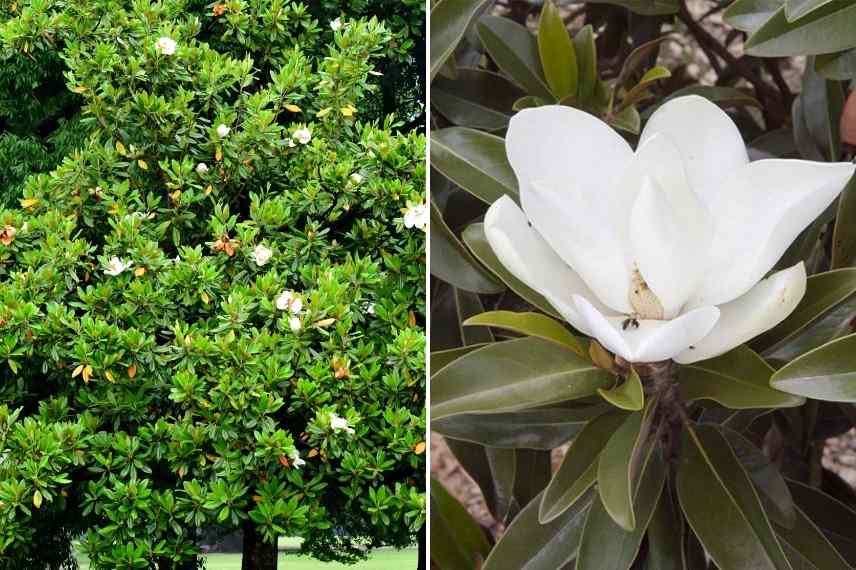
Magnolia grandiflora ‘Alta’
→ Discover our complete fact sheet on Magnolias
Japanese loquat (Eriobotrya japonica): exotic charm guaranteed
Here is another small evergreen tree that thrives in small urban gardens, as shown by number of loquats planted in Paris region. Planted in sun or partial shade, sheltered by walls, this small tree native to Japan does not suffer from winter winds in small town gardens. I like its large leathery leaves, with strongly marked veins, giving it an almost tropical appearance. Measuring about 5 m high with a spreading of 4 m, spreading habit of the Japanese loquat is truly magnificent, and acts as small shade tree. Its autumn flowering is fragrant and melliferous. It can be planted in all soils, even dry ones; it tolerates down to -10°C. Loquat requires no maintenance, unless you want light pruning.
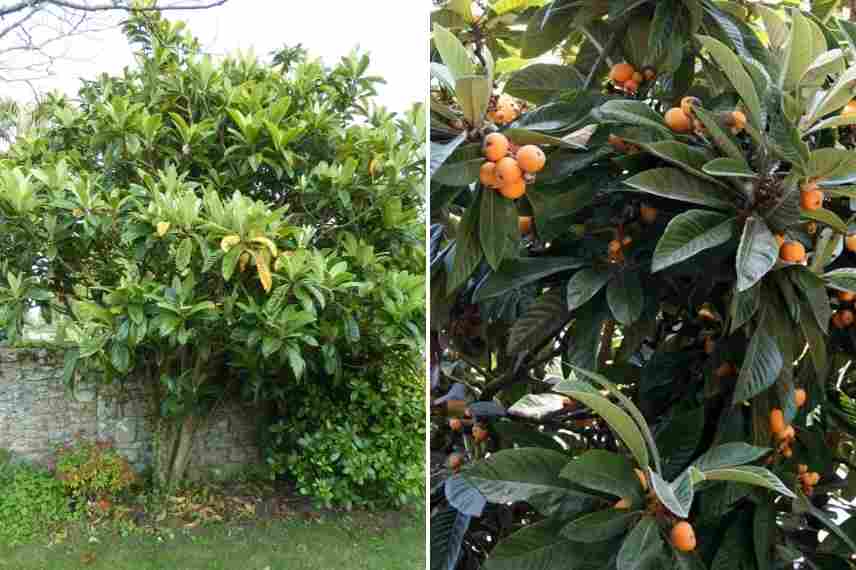
Eriobotrya japonica (Photos: G. David)
Catalpa bignoinoides 'Nana': a shade tree for small gardens
Catalpas are large trees with a broad crown and divine flowering, but their “dwarf” version allows you to plant in your small city garden a delightful ball-shaped habit: Catalpa bignoinoides ‘Nana’ will not flower, unlike trees exceeding 15 m. But with its 5 m high by 3 m spreading, trained on a high stem, it forms a true leafy parasol, and fits into practically all small city gardens, in full sun. Its deciduous foliage is slightly smaller than common Catalpa, but still has a lovely exotic appearance. Plant it as a solitary specimen — that’s how it is best showcased!
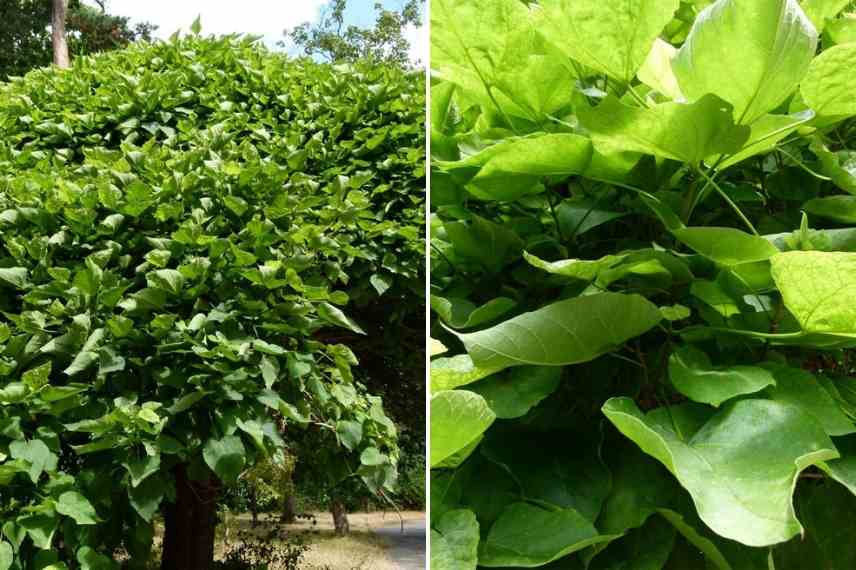
Catalpa bignoinoides ‘Nana’
→ Discover our complete fact sheet on the Catalpa
A palm tree for a change of scene in the heart of the city!
Palms are trees perfectly suited to small gardens, since their long stipe frees up space at ground level, carrying foliage high above, and above all providing a strikingly exotic presence much needed in towns! Many species do well in urban gardens, benefiting from a sheltered, wind-protected position, as some are much hardier than expected. Most require well-drained, dry soil to develop, so they withstand low winter temperatures in France better. Avoid soils that remain wet over winter.
Thus, Trachycarpus fortunei, also called hemp palm or Chinese windmill palm, is the reference that grows almost everywhere, being so hardy (down to -15°C!). It tolerates both sun and partial shade, with a west-facing aspect ideal. Reaching between 6 and 10 m at maturity, it remains compact in spread, about 2 m at the level of its palmate foliage. If you pair it with other dwarf palms with very short stipes, such as a compact Chamaerops humilis, a Sabal etonia or a Rhapsis excelsa, slow-growing species, you recreate a small, wonderfully authentic exotic microcosm!

Trachycarpus fortunei, Sabal leaf, Rhapsis excelsa
→ Discover our full fact sheet on the Hemp palm and on Chamaerops
And also
This selection is far from exhaustive… You can also steer your choice towards conifers with a columnar habit, truly perfect for introducing verticality and dynamism, and so handy for screening an unsightly pylon from view just behind your hedge or fence! Taxus baccata fastigiata ‘Aurea’ with luminous foliage, and Mediterranean Cupressus sempervirens are particularly ornamental. Wider cultivars of Chamaecyparis obtusa are equally suited to a garden where space is limited.
Some fastigiate varieties of Liquidambars, maples or Prunus, some Lagerstroemia, a Koelreuteria… also work… options are plentiful!
Feel free to consult Virginie’s advice sheet on the trees for small gardens which will give more planting ideas, and our advice sheet on the bushes for city gardens to complete your layout.
- Subscribe!
- Contents
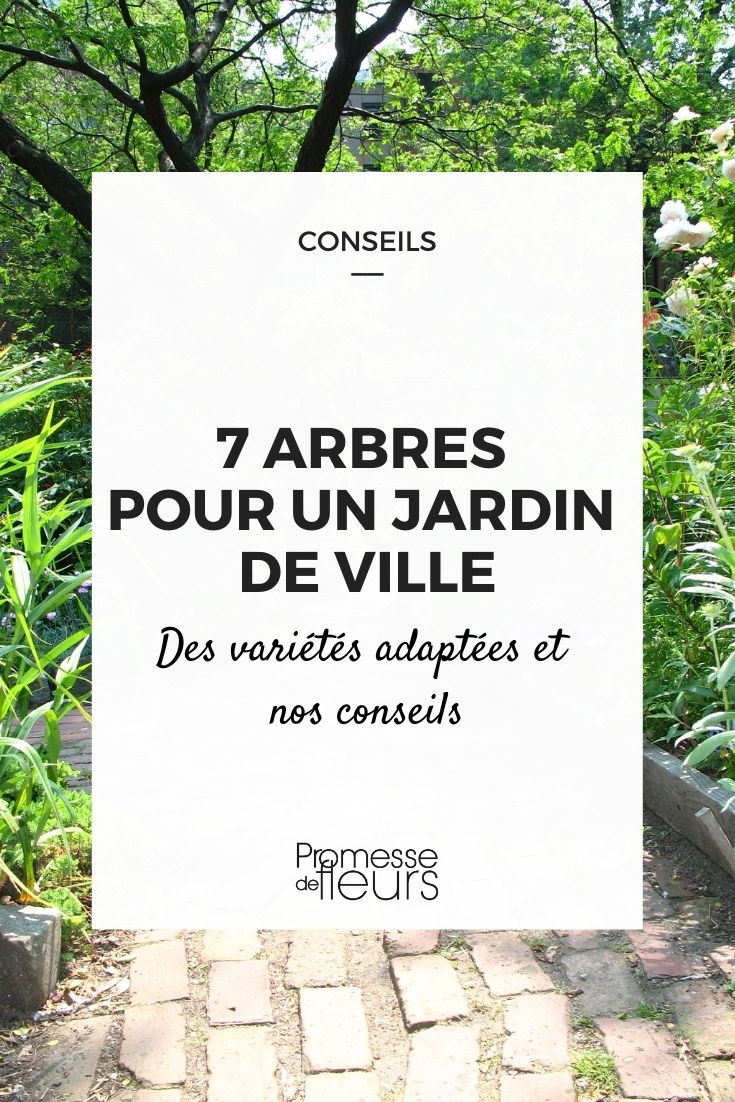































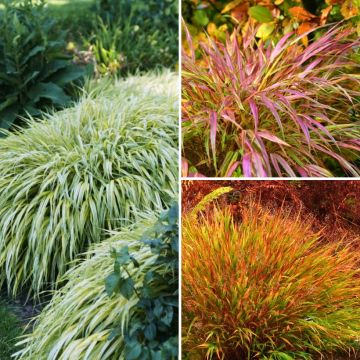

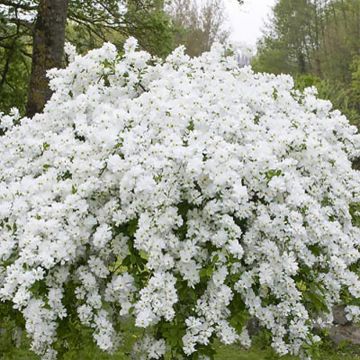

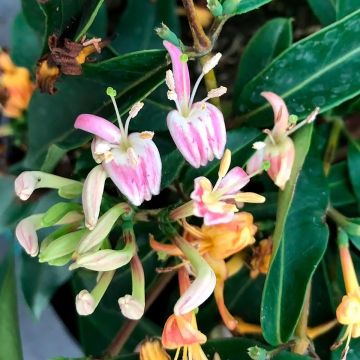
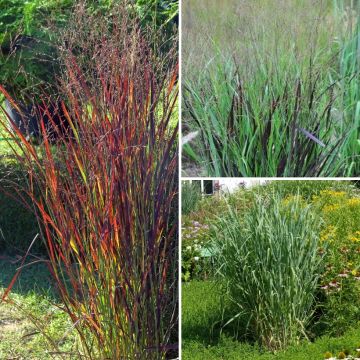
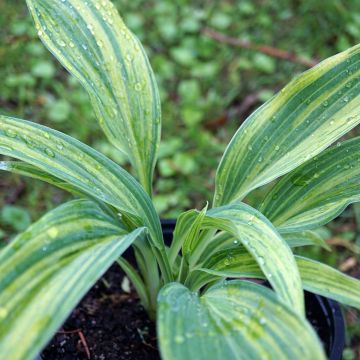
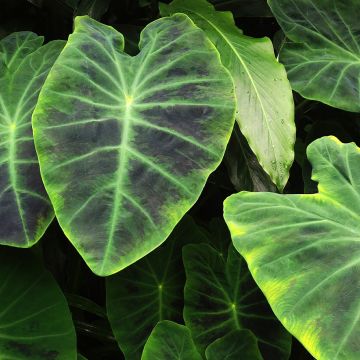
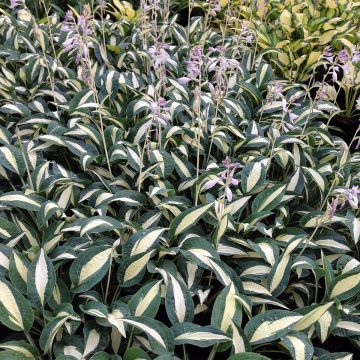

Comments